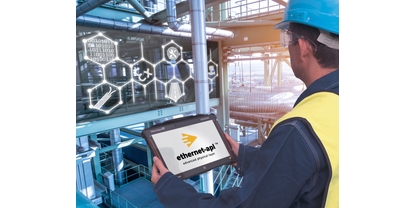Ethernet-APL: Frequently asked questions
Learn more here!
Ethernet-APL is a new technology that goes beyond the control level and the field level; it can change the complete infrastructure of a process plant. Let’s answer the questions most people ask when considering Ethernet-APL.
Benefits
Find frequently asked questions.
Read the answers.
Get more insights.
Ethernet-APL: Question 1
What components are required to set-up an Ethernet-APL network?
PLC/DCS: Many common systems can already operate with industrial Ethernet protocols such as PROFINET.
APL Switches: Depending on the plant’s requirements and network topology, you may need APL field switches, APL power switches or both to connect to the field.
APL Field Devices: You’ll need sensors and actuators with Ethernet-APL technology to connect to the switches. Network topologies with mixed technologies can help with devices that lack native Ethernet-APL connectivity.
Cables: To connect APL components with each other, you need Fieldbus cable type A, as specified in IEC 61158-2. It covers all requirements of the APL specifications and supports the maximum cable lengths.
We have a video that can explain in more depth.
Ethernet-APL: Question 2
How do Ethernet-APL and industrial Ethernet protocols like PROFINET, EtherNet/IP or Modbus TCP work together?

Designed specifically for process automation, Ethernet-APL is an advanced physical layer for Ethernet that sends power and data out to the field, even in hazardous areas, through one cable.
As for the protocols, according to the ISO OSI model, the upper layers are independent of the physical layer. Therefore, any kind of industrial Ethernet protocol and standard Ethernet application can work with Ethernet-APL.
Endress+Hauser has begun with PROFINET, with EtherNet/IP and Modbus TCP to follow. PROFINET and EtherNet/IP have specified device profiles, multiple redundancy mechanisms, and solutions for security and safety. Modbus TCP is easy to integrate but has limited standardization.
Ethernet-APL: Question 3
Will Ethernet-APL work for functional safety applications?
Yes, because the upper-level software stacks will handle the requirements. PROFINET has the “black-channel” principle and a software layer called “PROFIsafe” which has supported factory automation for years already.
Find out more in the official whitepaper, “Ethernet-APL for high-availability safety applications.”
Ethernet-APL: Question 4
How do I access APL field devices to set parameters or troubleshoot?
Engineering system: For basic setups, you can use the GSD device driver, which provides NAMUR NE131 core parameters.
Asset management: The device driver will help here too. For APL devices, Endress+Hauser will offer FDI packages, the latest device-driver technology.
P2P via network: All Endress+Hauser APL devices have an embedded web server for full access to setup, diagnostics and report creation. You only need a standard web browser and the device’s IP address to get started.
P2P locally: All Endress+Hauser APL devices offer local interfaces for direct connection. Depending on the device, you can access it through the service interface (CDI), Bluetooth or the local display.
Ethernet-APL: Question 5
How can I start using Ethernet-APL in my plant?
Ethernet-APL networks need specific components, so you’ll encounter different challenges depending on whether you have a greenfield or brownfield project.
Greenfield: Obviously, it’ll be easier to set up and adapt APL topologies from scratch. But if you need device types that lack Ethernet-APL, you’ll have to work a bit more.
Fortunately, APL field switches support both PROFINET-APL and PROFIBUS PA devices at the same switch. And you can integrate analog HART devices into the Ethernet backbone via Ethernet-enabled remote IOs.
Get ready for the future by using Ethernet-APL technology in new projects!
Brownfield: So what do you have – a central IO with a marshalling rack? Remote IOs integrated to PROFIBUS DP? FOUNDATION Fieldbus? Something else?
Whatever you have, you can migrate to Ethernet-APL, but you have to find the most cost-effective way to do it. Plant modernizations, extensions or phase-outs are perfect opportunities to think about migrating to Ethernet-APL.
You can replace remote IOs, junction boxes or field barriers with APL field switches. Swap out cables with Fieldbus type A for trunk-and-spur topology or Ethernet/fiber-optics for star. An Industrial Ethernet interface in your controller, and you’ll be set in no time!
Go from analog to digital with Ethernet-APL!


